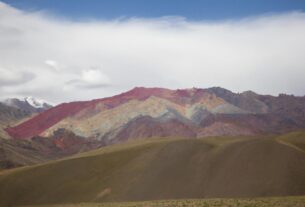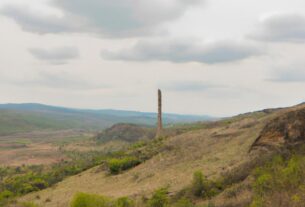The Indian Statue of Unity, situated in the state of Gujarat, is more than just a statue – it’s a masterpiece of engineering and a testament to India’s rich history. Towering 182 meters high, this magnificent statue depicts Sardar Vallabhbhai Patel, a revered statesman who played a vital role in India’s independence movement. Since its unveiling in 2018, the statue has captivated the hearts of visitors from all over the world, becoming a major tourist attraction in India.
Design and Construction
The genius behind the Indian Statue of Unity is Ram V. Sutar, an acclaimed Indian sculptor renowned for his exceptional creations. Adorned in bronze, Patel stands tall above the Narmada River, elegantly draped in a dhoti and shawl. Surrounding the statue is a sprawling complex that houses a museum, an audio-visual gallery, and a research center dedicated to Patel’s illustrious life and contributions.
The construction of this monumental statue took nearly four years to complete and came with an estimated cost of approximately $430 million. Spearheaded by Larsen & Toubro, a leading engineering and construction firm, along with the collaboration of several other companies, the statue’s core was crafted with reinforced concrete, while its exterior features bronze panels. These panels, cast in China, were meticulously transported to India for assembly. On October 31, 2018, the statue was proudly inaugurated by Indian Prime Minister Narendra Modi, who hailed it as a symbol of unity and strength for India.
Size and Dimensions
The Indian Statue of Unity stands tall as the world’s tallest statue, reaching a height of 182 meters (597 feet). Interestingly, the height was deliberately chosen to be twice that of the iconic Statue of Liberty in the United States. Weighing a staggering 67,000 metric tons, the statue is one of the heaviest in the world. Perched upon a 58-meter (190-feet) high base, the statue offers visitors an observation deck and a museum to explore.
Drawing comparisons to other renowned statues worldwide, the Indian Statue of Unity surpasses the Spring Temple Buddha in China by over 50 meters (164 feet). The Spring Temple Buddha, currently the second tallest statue globally, stands at 128 meters (420 feet). Such grandeur and scale astound all who lay their eyes upon it.
A Tourist Attraction of Epic Proportions
Since its unveiling, the Indian Statue of Unity has become a mesmerizing magnet for tourists. People flock from all corners of the globe to witness its extraordinary size and captivating design. Nestled alongside the Sardar Sarovar Dam, the statue boasts a breathtaking backdrop, creating picture-perfect moments for visitors. Exploring the complex is a delight, offering access to a museum, an audio-visual gallery, and a research center, all devoted to preserving Patel’s legacy.
Visitors can partake in a myriad of activities, including a picturesque river cruise on the Narmada River, a captivating light and sound show, and a panoramic view from the observation deck. Additionally, the statue’s popularity has spurred the development of nearby attractions such as a butterfly park, a cactus garden, and even a thrilling jungle safari park.
Promoted by the Indian government as a symbol of unity and a catalyst for increased tourism, the statue has undeniably achieved outstanding success since its inauguration, exceeding all expectations.
Controversies and Criticisms
Despite its allure, the Indian Statue of Unity has not been immune to controversy and criticism. Detractors point to its high cost, estimated at $430 million, arguing that such funds could have been allocated to pressing issues like poverty alleviation and education to uplift the nation further.
Environmental concerns also surround the statue’s construction. Situated on a river island within a delicate ecological zone, worries have emerged regarding potential adverse effects on local flora and fauna. The government has, however, defended the construction as environmentally sustainable, committing to preserving the local ecosystem.
Moreover, the controversy has extended to local communities who feel that their land and livelihoods were adversely affected by the statue’s construction. They argue that adequate compensation has not been provided. In response, the Indian government assures local residents that economic benefits will be reaped from the statue, alongside efforts to address their concerns.
Critics Speak Out
Despite the statue’s status as a prominent tourist attraction, critics, including environmentalists and local residents, lend their voices to the ongoing discourse. Environmentalists express concerns about the statue’s impact on the Narmada River, a vital water source for millions of people in India. They contend that the construction and associated infrastructure have disrupted the river’s ecosystem and affected local communities.
Residents of Gujarat, the state where the statue stands, also express discontent, believing that the vast resources allocated to the statue could have been better used to address pressing social and economic issues. Poverty, lack of healthcare, and limited access to education are some of the challenges faced by many Gujaratis. They argue that the funds expended on the statue could have been directed towards improving their quality of life.
Nonetheless, the Indian government staunchly defends the statue’s construction, emphasizing its significance as a symbol of national unity and pride. Furthermore, the government highlights the statue’s potential to boost tourism and stimulate economic growth in the region.
In Conclusion
Undeniably, the Indian Statue of Unity stands as a remarkable engineering marvel, embodying India’s unity and strength. Its sheer size and dimensions are awe-inspiring, complemented beautifully by its location on the Narmada River. Since its unveiling, the statue has garnered attention worldwide, drawing millions of visitors who are enchanted by its grandeur.
While it is essential for the government to continue investing in the region’s development, it is equally vital to ensure the preservation of the area’s natural splendor. As TooLacks, we admire the Indian Statue of Unity’s breathtaking achievement, but we also advocate for responsible development that safeguards the environment and supports the well-being of local communities.
For further information about TooLacks, visit TooLacks.


